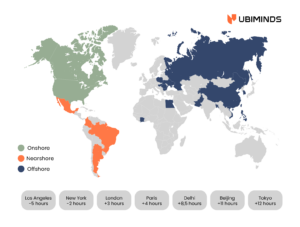Managing a scattered team across time zones? Time zone challenges can cause communication gaps, hinder productivity, and lead to frustration. But fear not! With strategic scheduling, asynchronous tools, and cultural sensitivity, you can conquer time zones and build a thriving distributed team!
Four Strategies for Overcoming Time Zone Challenges
Time zone differences can make or break a distributed team. Strategic scheduling and using tools like World Time Buddy or Google Calendar can simplify coordination across time zones. Encourage asynchronous communication where possible, so team members can work at their peak times without waiting on others.
#1 Comprehensive Documentation
- Centralized Knowledge Base: Maintain detailed and up-to-date documentation accessible to all team members. This should include project guidelines, meeting notes, coding standards, and decision logs. Tools like Confluence or Notion can serve as a central repository, ensuring that everyone, regardless of time zone, has the information they need to keep the project moving forward.
- Standard Operating Procedures (SOPs): Create SOPs for recurring tasks and processes. This helps team members execute their responsibilities consistently, even if they work asynchronously.
#2 Sync and Async Hours
- Overlap Hours: Establish a few hours of overlapping work time where team members in different time zones can collaborate in real-time. This time should be used for meetings, discussions, and activities that require immediate feedback or brainstorming.
- Asynchronous Workflows: Encourage async communication for tasks that don’t require instant responses. Tools like Slack, Trello, and Asana support asynchronous collaboration by allowing team members to leave updates, comments, and tasks for others to pick up when they are online.
#3 Flexible Scheduling
- Rotating Meeting Times: For regular meetings, rotate the timing to share the inconvenience across time zones. For example, if one meeting is convenient for one region this week, the next meeting can be more favorable for another region.
- Recorded Meetings: Record meetings for those who can’t attend due to time zone differences. Tools like Zoom and Microsoft Teams allow meetings to be recorded and shared, enabling all team members to stay informed.
#4 Cultural Sensitivity
- Respect Local Holidays and Working Hours: Be mindful of the local holidays, weekends, and working hours of each team member. This shows respect for cultural differences and prevents burnout.
- Regular Check-Ins: Schedule periodic one-on-one check-ins with team members to ensure they feel supported and aligned, even when working remotely or asynchronously.

When comparing Onshore, Nearshore and Offshore Services, Brazil’s Location and Time Zone overlap are a bonus to US companies
Determining Group vs. Individual Work: Synchronous and Asynchronous Solutions
To effectively manage distributed teams across time zones, it’s essential to determine which tasks require synchronous collaboration and which can be handled asynchronously.
- Synchronous Tasks: Tasks that require real-time communication, brainstorming, or decision-making should be scheduled for synchronous collaboration. This often involves meetings, video calls, or live discussions.
- Asynchronous Tasks: Tasks that can be completed independently, without requiring immediate feedback or input from others, can be handled asynchronously. This allows team members to work on tasks at their own pace, regardless of time zone differences.
For more lessons on how to coordinate the team and boost performance, read Build High-Performing Engineering Teams: Best Practices, Tips, and Insights.
Leveraging Technology for Time Zone Management
Several tools can help your team manage time zone differences and streamline collaboration:
- Calendar Apps: Google Calendar and Outlook offer features like time zone conversion and shared calendars to help teams schedule meetings across different time zones.
- Time Zone Converters: Online tools like World Time Buddy can help you visualize time differences and plan meetings accordingly.
Asynchronous Communication Tools: Platforms like Slack, Asana, and Trello facilitate asynchronous communication, allowing team members to leave comments, updates, and tasks for others to address at their convenience. - Video Conferencing Tools: Zoom, Microsoft Teams, and Google Meet are essential for conducting virtual meetings and maintaining face-to-face interactions.
Want to dive deeper? Have a look at these articles too:
- Work From Home Productivity: 7 Essential Tips & Tools for Success
- 5 Best Product Management Tools for Streamlining Software Development (Features + Pricing)
Why Nearshore Staffing is a Game-Changer for Distributed Teams
When building a distributed team, one of the biggest challenges to overcome is time zone differences. However, nearshore staffing can significantly mitigate these challenges, allowing teams to work together more effectively and efficiently.
- Significant Time Zone Overlap: Nearshoring involves working with teams in neighboring countries, often within the same time zone or with minimal time zone differences. This allows for more synchronous collaboration and reduces the need for extensive asynchronous communication.
- Cultural Proximity: Nearshore teams often share similar cultural backgrounds, making it easier to establish effective communication and build strong relationships.
- Reduced Communication Barriers: With fewer language and cultural barriers, nearshore teams can communicate more easily and efficiently.
- Cost-Effective Option: Nearshoring can offer a cost-effective solution compared to onshore or offshore staffing, without sacrificing quality or talent.

Companies are increasingly turning to nearshore solutions to fill these critical roles efficiently and cost-effectively.
Ubiminds: Your Partner for Seamless Nearshore Collaboration
At Ubiminds, we specialize in building high-performing distributed teams through nearshore staffing. We handle all aspects of team setup, from talent acquisition to onboarding and ongoing management.
Our expertise in remote work management ensures a smooth transition and effective collaboration. We’ll guide you through the process, help you select the right nearshore talent, and provide ongoing support to ensure your team’s success.
Contact us today to learn more about how Ubiminds can help you build a thriving distributed team without the hassle of time zone challenges.
Time Zone Challenges FAQ
-
Q: How can I schedule meetings for a distributed team across time zones?
A: Establish “core hours” where everyone is online, rotate meeting times, and encourage asynchronous communication for non-urgent matters. -
Q: What are some good tools for asynchronous communication?
A: Slack, Trello, and Asana are popular options. -
Q: How can I ensure my team members feel supported despite the time difference?
A: Schedule regular check-ins, respect local working hours, and create a culture of trust and understanding.

International Marketing Leader, specialized in tech. Proud to have built marketing and business generation structures for some of the fastest-growing SaaS companies on both sides of the Atlantic (UK, DACH, Iberia, LatAm, and NorthAm). Big fan of motherhood, world music, marketing, and backpacking. A little bit nerdy too!


